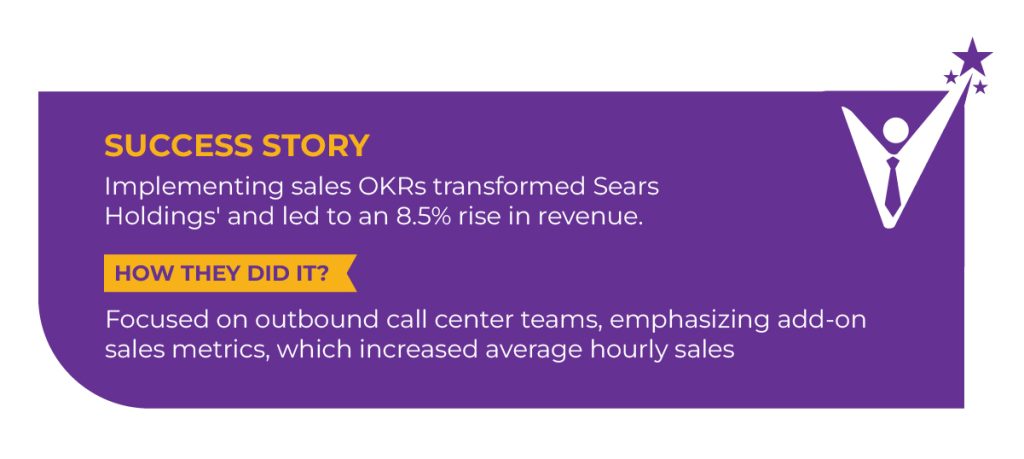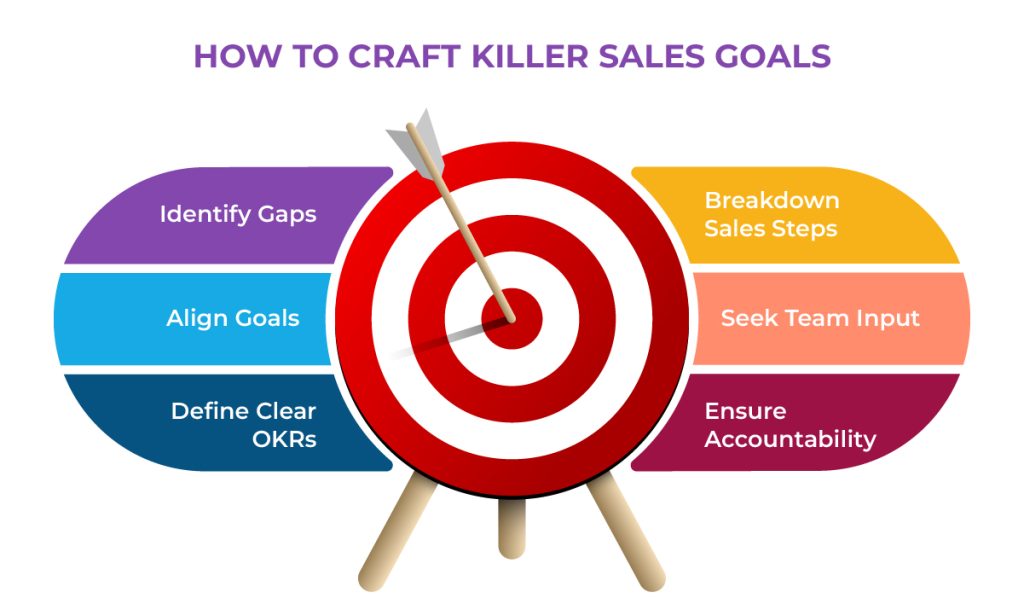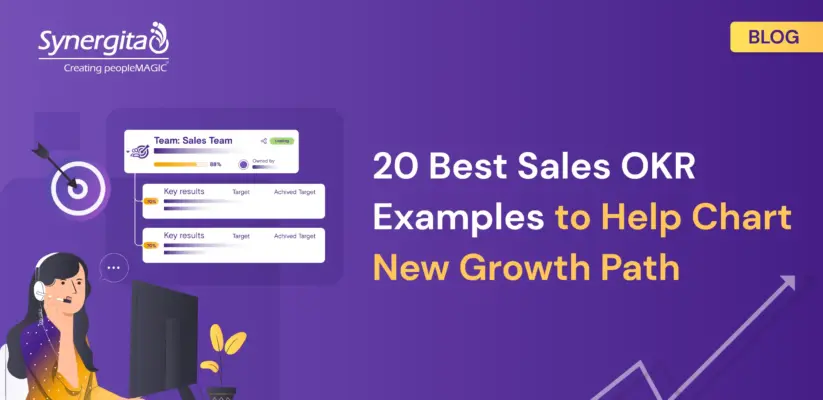20 Best Sales OKR Examples to Help Chart New Growth Path
What’s better than meeting expectations? It’s exceeding them! This is especially true for sales teams of organizations. But aiming high doesn’t happen by aggressive pursuit of monthly sales targets alone, it requires thinking out-of-the-box, taking risks, and being aligned with the company’s larger vision. This is where objectives and key results (OKRs) make a difference. While monthly sales targets are indicators of how the company is performing, sales OKRs are about what the company can do.
Scaling New Heights With Sales OKRs
What’s better than meeting expectations? It’s exceeding them! This is especially true for sales teams of organizations. But aiming high doesn’t happen by aggressive pursuit of monthly sales targets alone, it requires thinking out-of-the-box, taking risks, and being aligned with the company’s larger vision. This is where objectives and key results (OKRs) make a difference. While monthly sales targets are indicators of how the company is performing, sales OKRs are about what the company can do.
Further, sales teams thrive when working in collaboration with other departments such as development, marketing, and client satisfaction. OKRs provide that much-needed alignment across teams. A transparent OKR scoreboard enhances teamwork and accountability, ensuring everyone is working towards shared objectives. While every team member has unique strengths and aspirations, syncing personal objectives with broader organizational goals encourages individuals to drive team success.

Strategic OKR Samples To Help You Get Started
The resilience of a sales team’s success is not just about reaching targets but also about adapting to the twists and turns of the market landscape. The right OKRs serve as the agile steering mechanism, allowing sales professionals to adjust their strategies in response to market shifts and ensure long-term success and endurance in the competitive sales landscape.

Here are some model OKRs to get the best out of your sales team:
Objective 1: Launch a new product line
- KR1: Achieve $500,000 in pre-launch sales through targeted marketing efforts.
- KR2: Secure partnerships with three influential industry blogs for product reviews.
- KR3: Attain a customer satisfaction rating of 4.5 out of 5 in post-launch surveys.
Objective 2: Enhance e-commerce sales
- KR1: Increase online conversion rates by 20% through website optimization.
- KR2: Implement a referral program, resulting in a 15% growth in online sales.
- KR3: Launch a mobile app, contributing to a 25% increase in mobile-based transactions.
Objective 3: Improve cross-selling
- KR1: Increase the average number of products per transaction by 10%.
- KR2: Implement targeted cross-selling training for sales reps, resulting in a 15% improvement.
- KR3: Achieve a 20% increase in revenue from cross-selling initiatives.
Objective 4: Optimize pricing strategy
- KR1: Conduct market research to identify optimal price points for key products.
- KR2: Implement a dynamic pricing model, resulting in a 10% increase in overall sales revenue.
- KR3: Achieve a customer satisfaction rating of 80% or above regarding pricing transparency.
Objective 5: Strengthen client relationships
- KR1: Conduct quarterly business reviews with top-tier clients, resulting in a 15% increase in upsells.
- KR2: Implement a client feedback system, aiming for a satisfaction rating of 95%.
- KR3: Reduce response time to client queries by 20% through improved communication channels.
Objective 6: Penetrate a niche market
- KR1: Research and identify key players and trends in the niche market.
- KR2: Secure partnerships with two prominent influencers in the niche.
- KR3: Achieve a 12% market share within the niche market within the next quarter.
Objective 7: Enhance social selling effectiveness
- KR1: Increase engagement on social media platforms by 30%.
- KR2: Train sales reps on effective social selling techniques, resulting in a 25% improvement.
- KR3: Generate 15% of total sales from social media leads.
Objective 8: Streamline sales processes
- KR1: Implement a CRM system, resulting in a 20% reduction in administrative tasks.
- KR2: Achieve a 15% improvement in sales pipeline visibility through process optimization.
- KR3: Reduce the average time spent on manual data entry by 25%.
Objective 9: Achieve regional sales expansion
- KR1: Identify and enter three new regional markets within the next fiscal year.
- KR2: Establish local partnerships for distribution, contributing to a 15% increase in regional sales.
- KR3: Adapt marketing strategies for regional preferences, resulting in a 10% growth in market share.
Objective 10: Improve sales team collaboration
- KR1: Implement a team-building program, resulting in a 20% improvement in team collaboration.
- KR2: Conduct weekly cross-functional meetings to enhance communication and coordination.
- KR3: Achieve a 15% increase in joint sales initiatives between team members.
Objective 11: Enhance lead quality
- KR1: Implement a lead scoring system, resulting in a 30% improvement in lead quality.
- KR2: Collaborate with marketing to refine target audience profiles for better-qualified leads.
- KR3: Achieve a 25% reduction in unqualified leads through improved lead generation strategies.
Objective 12: Boost sales training effectiveness
- KR1: Conduct regular assessments, aiming for a 15% improvement in sales training test scores.
- KR2: Implement personalized training plans based on individual sales rep performance.
- KR3: Achieve a 20% increase in the application of training knowledge in real-world scenarios.
Objective 13: Enhance customer onboarding
- KR1: Reduce customer onboarding time by 25% through streamlined processes.
- KR2: Implement a customer onboarding feedback system, aiming for a 90% satisfaction rating.
- KR3: Achieve a 15% reduction in customer churn within the first three months of onboarding.
Objective 14: Improve email marketing impact
- KR1: Increase email open rates by 20% through personalized and targeted campaigns.
- KR2: Implement A/B testing for email content, resulting in a 15% improvement in click-through rates.
- KR3: Achieve a 25% increase in sales attributed to email marketing efforts.
Objective 15: Expand partnership channels
- KR1: Identify and establish partnerships with three new industry-related organizations.
- KR2: Achieve a 20% increase in revenue from existing partnership channels.
- KR3: Secure co-marketing agreements with two key partners, contributing to increased brand visibility.
Objective 16: Improve sales forecast accuracy
- KR1: Implement advanced analytics tools for sales forecasting, aiming for a 90% accuracy rate.
- KR2: Conduct regular reviews and adjustments to forecast models based on historical data.
- KR3: Achieve a 15% reduction in forecasting errors through continuous refinement.
Objective 17: Enhance sales presentation effectiveness
- KR1: Implement training on persuasive presentation techniques, resulting in a 20% improvement.
- KR2: Achieve a 15% increase in positive client responses to sales presentations.
- KR3: Implement a feedback system for sales presentations, aiming for an 80% satisfaction rating.
Objective 18: Improve sales data security
- KR1: Implement data encryption protocols for all sales-related databases.
- KR2: Conduct regular security audits, aiming for a 100% compliance rating with industry standards.
- KR3: Achieve zero data breaches related to sales information within the next fiscal year.
Objective 19: Enhance sales response time
- KR1: Implement an automated response system for customer queries, resulting in a 30% reduction in response time.
- KR2: Train sales reps on effective communication strategies for quicker response and resolution.
- KR3: Achieve a 25% improvement in customer satisfaction related to response times.
Objective 20: Foster innovation in sales strategies
- KR1: Establish a cross-functional innovation task force within the sales department.
- KR2: Implement at least three innovative sales strategies within the next quarter.
- KR3: Achieve a 10% increase in revenue attributed to newly implemented innovative sales approaches.
Road To Success Begin Here
In the dynamic realm of sales, relying solely on the drive for numbers without a structured approach can be akin to navigating unfamiliar terrain without a roadmap. OKRs become the essential roadmap, offering specific objectives as destinations and key results as the checkpoints along the way. This strategic alignment not only guides the team but also provides measurable milestones to gauge progress, making the journey more purposeful and sustainable.
Unlock your transformative potential with Synergita OKR, because the secret to being indomitable is having a strategic plan. Our intuitive platform bridges the gap between dreams and reality, turning your sales objectives into tangible success faster than you can say “closed deal”. With Synergita’s customizable OKR solution, you’ll not just be hitting targets, but surpassing them.
To know more about Synergita OKR visit the website or sign up to begin your OKR journey now! To make it easier to get started on writing OKRs for your team, check out our blog on Synergita OKR templates, these give a peek at the ready-made sample OKRs for you to use.
